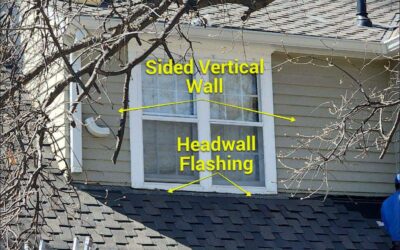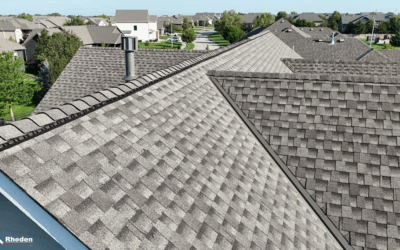What Are Powered Attic Fans and What Do They Do?
A powered attic fan is an electrically powered roof-mounted ventilation device that actively exhausts warm and moist air from the attic space. Unlike static vents, it uses a dedicated motor, thermostat, and humidistat to actively move air when needed rather than relying on passive ventilation. When the attic temperature or humidity rises beyond a predetermined threshold, the fan activates, expelling attic air through its opening on the roof.
Powered attic fans are used when static vents aren’t an option. Like putting a vacuum on the attic space, they draw air from wherever it’s easiest to get, and that can include conditioned living spaces, absent proper air intake. We always start with passive ventilation options and only consider a powered fan after those have been ruled out.
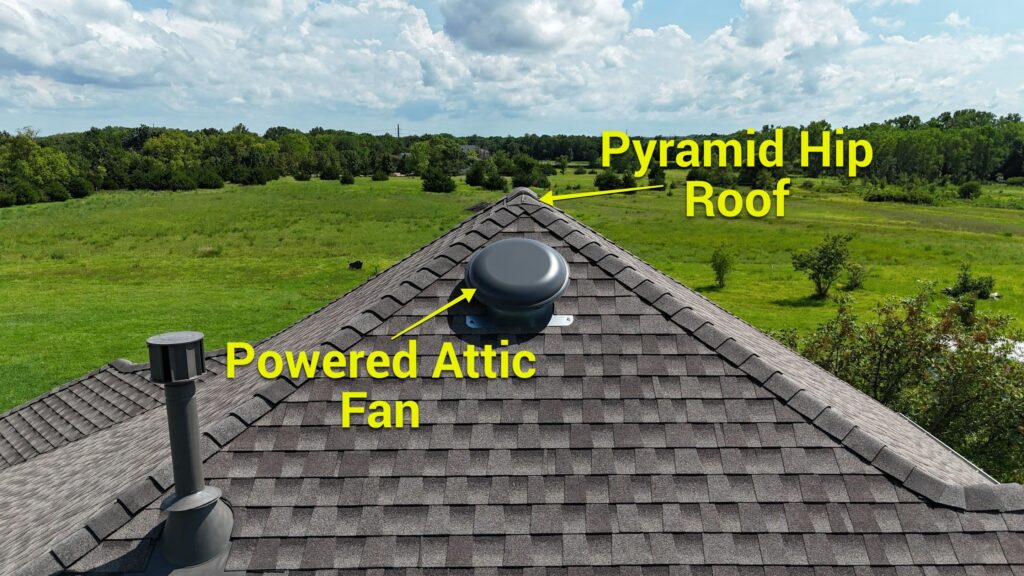
Here is how we decide which type of exhaust a roof system will use.
-
- Ridge Vent: Balanced, continuous ridge ventilation is the simplest, most effective, and most leak-resistant exhaust solution for enclosed attics that have an uninterrupted ridge of adequate length.
When It Doesn’t Work: If the roof does not have continuous ridge of adequate length (e.g., short ridgelines, multiple small hip roofs, or a steep pyramid hip), or if there are multiple separated attic spaces that preclude a single continuous ridge vent for each, it can’t provide the necessary exhaust. - Box Vents or Turbines: These are passive exhaust options that work for most attic spaces. We use these when continuous ridge vent isn’t feasible but there are roof planes that can accept enough individual vents near their peak to provide adequate attic ventilation.
When They Don’t Work: Box vents and turbines are ineffective when they can’t be placed at or near the peak of the roof. This can occur on pyramid hip roofs that don’t have room at the peak for a sufficient number of vents, or where they are unable to uniformly pull air from the entire attic space. - Powered Attic Fan: When passive exhaust options can’t deliver balanced attic ventilation because of the attic’s geometry, structural constraints, or prohibitively small roof peaks, a powered fan is used instead. A powered unit actively moves large volumes of air even with complex attic geometry.
Key Considerations: Passive ventilation is simply more reliable for the same reason a bicycle is more reliable than a motorcycle: fewer moving parts. If a powered fan is chosen, it’s critical to ensure that the attic space has adequate intake. Combustion-safety should also be practiced if the house has fuel appliances due to the risk of depressurization if the powered vent is chosen recklessly.
That being said, powered attic fans are powerful air-movers that can comfortably exhaust large, atypical attic structures when static vents are not viable.
- Ridge Vent: Balanced, continuous ridge ventilation is the simplest, most effective, and most leak-resistant exhaust solution for enclosed attics that have an uninterrupted ridge of adequate length.

Example 1
This house has multiple separated attic spaces that prevented the use of continuous venting ridge. Powered attic fans would draw more air than the soffit vents could provide, making static box vents a healthy option for balanced attic ventilation.

Example 2
The older a home is, the more likely it is to have add-ons. This house has multiple add-ons with one attic space and one large pyramid hip at the center. Because the roof’s pitch is relatively shallow (<5:12), the attic area is small enough that two wind turbines provide sufficient exhaust for the entire attic space.
Expected Service Life of Powered Attic Fans
Powered attic fans typically last 10 to 15 years, depending on the installation quality, ventilation balance, and motor quality. Because powered fans rely on motors, sensors, bearings, and wiring, they introduce more potential causes for failure than a traditional static vent.
We will primarily focus on the fan’s integration with the roof system and its ability to properly exhaust warm, moist air. Issues like motor burnout or electrical component failure may be observed during an inspection, but we strongly recommend consulting with a qualified electrician to address those.
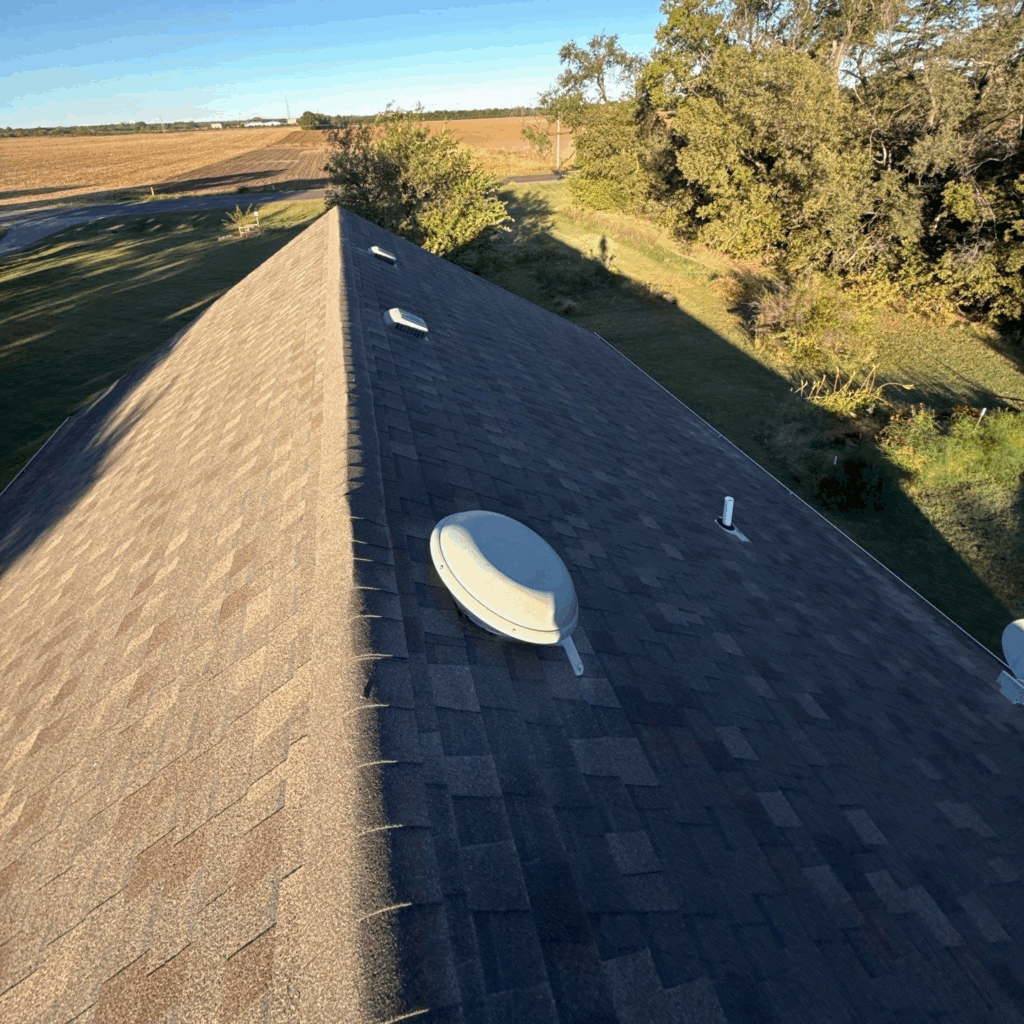
This roof’s attic space required more exhaust ventilation than its four existing box vents provided. The correct way to ventilate this attic space is to either 1) add two box vents to balance its ventilation, or 2) plug the box vents and add continuous ridge vents, which is what we generally recommend for roofs that require replacement. Instead, a powered attic fan was added. This short-circuited the exhaust, causing the box vents to function like intake vents. The lower half of the attic space was effectively unventilated as a result.
0-2 Years: New Installation – Evaluating for Correct Installation
Powered attic fans involve roofing, ventilation, and electrical work, which means an oversight in one element can undermine the others. Their built-in flashing is simple for experienced roofing contractors to integrate, which means that evaluating for correct installation relates mostly to ensuring the product’s service life isn’t shortened by inadequate intake, electrical issues, or improper fan placement.
-
- Power Connectivity: Reputable roofing contractors are roofing experts, not electrical experts. A qualified electrician or the homeowner is typically responsible for powering attic fans. Typically, the roofing contractor will install the fan and integrate it with the roofing system, then a qualified electrician will wire the fan in accordance with the manufacturer’s specifications. However, this needs to be communicated to the homeowner, otherwise it will be a roof decoration, not ventilating anything.
- Exposed Wires: This is common when powered attic fans are installed as a DIY project. Electrical connections should be housed in a junction box mounted on a joist or rafter.
- Inadequate Intake: Static vents require adequate intake, like soffit vents, to ensure balanced attic ventilation. Powered fans require adequate intake for another reason: without adequate intake, the fan may pull air from the conditioned living space and disrupt the building’s pressure balance. Installing the fan but ignoring where air comes in will do more harm than good. As with all attic ventilation systems, it’s critical to ensure that sufficient intake exists. Balanced attic ventilation provides one square foot of Net Free Area (NFA – open ventilating space) for every 300 square feet of attic floor area, which is typically 60 percent intake and 40 percent exhaust. For powered attic fans, this means that five square feet of intake area is required to match the fan’s exhaust capabilities and prevent it from pulling air from the living space.
- Mixed Exhaust Methods: Air should have a single exhaust method from the attic at or near the apex of the roof. Mixing exhaust methods (e.g., ridge vent paired with box vents lower on the roof for a single attic space) risks short-circuiting the ventilation system, no different from drinking through a straw with a hole in the middle: some air will make it to the end, but most of it will escape through the hole. This is especially important for powered vents, where actively pulling air amplifies this imbalance and risks negative pressure.
- Fan Installed Too Low: All exhaust vents must be placed as high on the roof as possible. This minimizes dead zones in the attic space where no airflow occurs.
- Improper Shingle Overlap: The upper half of the metal flashing slides beneath the overlapping shingles, while the lower half overlays the downslope shingles. The inverse invites water underneath the shingles.
- Exposed Nail Heads or Loose Nails: Exposed fasteners on the downslope side of the flashing invite leaks. They must be sealed with UV-resistant caulk or replaced if backing out.
2-5 Years: Normal Weathering – What to Monitor
After a few years of service, we shift from checking for correct installation to monitoring the early effects of weather exposure and mechanical wear. At this stage in a powered attic fan’s service life, most changes are superficial and do not directly affect its performance.
-
- Drying Sealant: The UV-resistant sealant protecting the fasteners may begin to dry and produce minor hairline cracks.
- Staining on Metal Components: The metal base flashing may develop staining, either as white mineral deposits from coating breakdowns or as small patches of reddish-brown oxidation – an early sign of rust.
- Minor Damage to Metals: Small indents from hail, tree limb abrasions, or incidental damage are common after a few years. These can occur both on the flashing or the vent’s hood, which is typically domed.
- Minor Bearing Noise: After a few years, the motor bearings might cause the fan’s noise to increase, typically as a hum or mild vibration.
- Dust Accumulation in Motor Casing: Like a ceiling fan, dust will naturally begin to accumulate around the fan and motor over time.
Maintenance: Reseal, paint, or schedule an inspection by an electrician. Minor, surface-level or hairline cracking of sealant is usually cosmetic, although reapplying sealant can preempt any potential avenues for water from progressive wear. Reapplying paint is similarly elective at this point since staining or discoloration does not affect the fan’s performance. Dust accumulation can be cleared with compressed air and a microfiber rag from the attic in most cases.
Moderately increased bearing noise is not typically urgent if the fan is running well, but it’s an opportunity to schedule an inspection with a licensed electrician if the noise is disruptive.
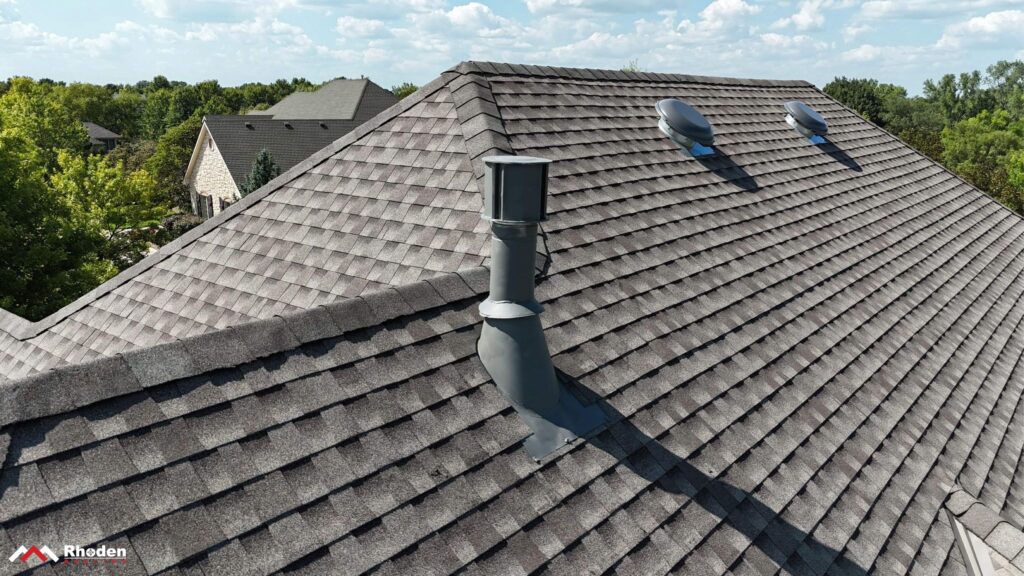
5-10 Years: Developing Signs of Aging – Proactive Care Recommendations
At this stage, we’re not inspecting for signs of catastrophic failure but for subtle signs of progressive wear.
-
- Exposed or Loose Fasteners Securing the Flashing: Deteriorated sealant around the base flashing’s fasteners allows water to seep into the fasteners’ holes. This can cause the fasteners to back out, creating an additional vulnerability.
- Thermostat or Humidistat Failure: If the fan is running continuously or failing to run at all, the sensor has likely begun to fail.
Maintenance: Apply sealant or call an electrician. Sealant should be reapplied where fasteners are exposed, and any loose fasteners should be hammered back down. Fans exhibiting cycling issues (e.g., running non-stop, erratic cycling, or inactivity) require an inspection by a licensed electrician. Not mentioned here are proactive fixes that an electrician might notice upon inspection, like recalibrating controls.
10-15+ Years: Failure & Replacement – Knowing When It’s Time
Proper attic ventilation is a prerequisite for many labor warranties, material warranties, and local building code. However, powered attic fans are likely to fail, or no longer effectively exhaust air from the attic space, before the roof system itself. The service life of a powered attic fan – a mechanically complex piece with moving parts – simply can’t match the lifespan of a simple piece of metal, like counterflashing.
To clarify what the thresholds for replacement are, we created an inspection checklist to standardize our recommendations, ensuring that it’s suggested only when it’s necessary. Similar to how an insurance adjust defines “totaled” on a car, we only recommend component replacement when the cost to replace a component or roof is less than the expected cost of damages over the next 12 months. For powered attic fans, we apply another criteria, mentioned above: an inability to exhaust air from the attic space.
Based on our experience identifying and fixing roof leaks on over 13,000 homes and buildings, here are our criteria for when we recommend replacement of a powered attic fan:
-
- Water intrusion – If moisture has already found its way through the flashing and into the interior, the flashing needs replaced. Interior leaks will be visible as discoloration to surrounding wood or insulation, grime lines or staining on the flue itself within the attic, mold, or wet spots on drywall or sheetrock below.
- Abrasive damage or cracks that are more than half the thickness of the material – such as from a branch falling, hail impact, or maintenance error.
- Warped Flashing: Deformation compromises the metal’s ability to seal and allows water to migrate under the flashing.
- Corroded metal deterioration with active pitting rust or rust located where sealant is applied. Pitting rust compromises the material and makes it ineffective at its job: to keep water out. Rust located where sealant is applied will prevent it from adhering altogether.
- Motor Burnout: A non-responsive fan or one that hums without spinning is likely to have a burnt-out motor.
- Worn Bearings: Mild bearing wear presents itself as a mild hum or vibration; significant bearing wear presents itself as a symphony of grinding and house-rattling vibration.
The latter three issues should be evaluated by a licensed electrician. Powered attic fans can fail in other ways, including faulty wires or deformed vent housing, that can be difficult for a roofing contractor to notice. If you suspect that your powered attic fan is not functioning properly, contact a licensed electrician followed by a trusted roofing contractor to ensure that the fan properly integrates with your roof.
Frequently Asked Questions (FAQ)
How much do powered attic fans cost?
$400-$1,000, including installation costs. The fan’s size, flashing complexity, and wiring requirements can greatly affect its cost. Installation costs are also affected by the roof’s pitch and the attic’s accessibility.
How many powered attic fans do you need to install on a roof?
The number of attic fans your roof needs depends on the attic’s size and the fan’s CFM (Cubic Feet per Minute), which measures how much air it can move per minute. A typical powered attic fan has 1500 CFM, which can sufficiently exhaust air from a 2,100 square-foot attic space (2,100 * 0.7 = 1,470, which is under the 1,500 CFM capacity of most powered attic fans). Larger attic spaces or attics with multiple enclosed attic spaces will require additional attic fans.
How loud are powered attic fans?
Most modern powered attic fans operate at approximately 45 decibels – roughly 1/3 the volume of a running microwave. However, improper fan installation and the wearing of ball bearings can cause the noise to increase.
This article is part of our ‘Roof Component Inspection & Service Life’ Series. Learn more about:
Flashing
Roof Vents


